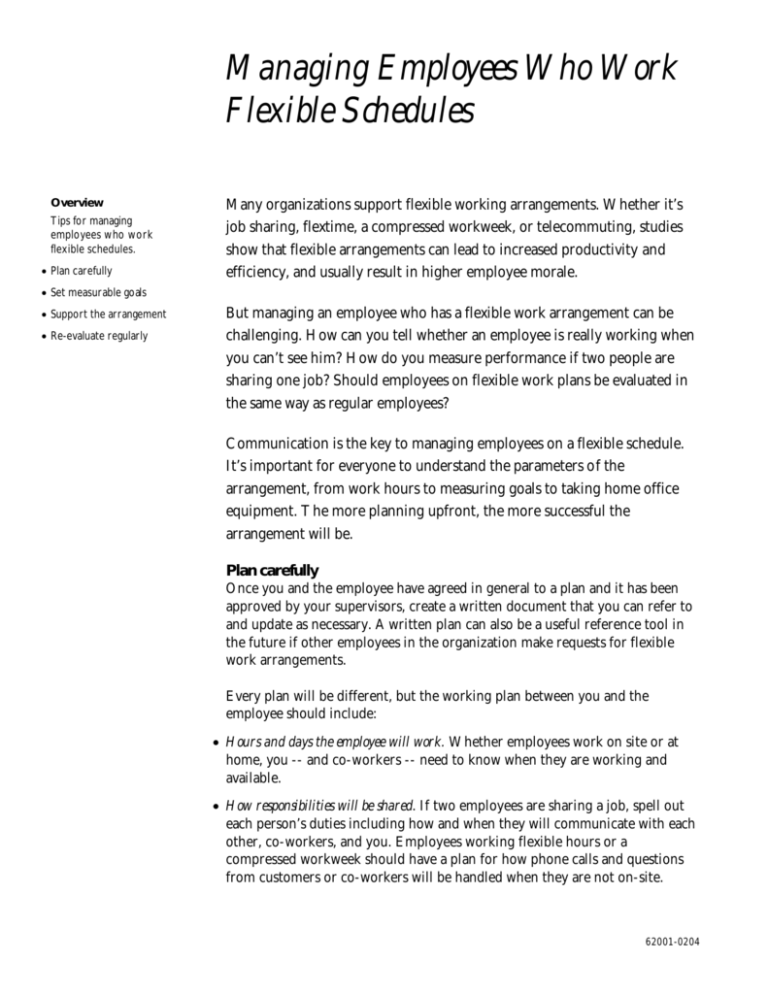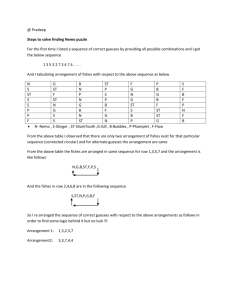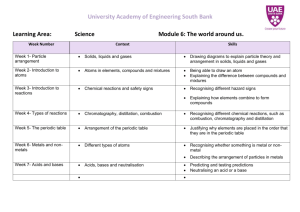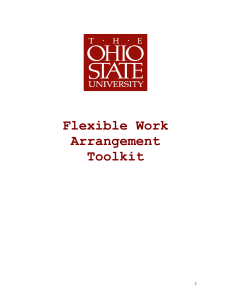
Managing Employees Who Work
Flexible Schedules
Overview
Tips for managing
employees who work
flexible schedules.
• Plan carefully
Many organizations support flexible working arrangements. Whether it’s
job sharing, flextime, a compressed workweek, or telecommuting, studies
show that flexible arrangements can lead to increased productivity and
efficiency, and usually result in higher employee morale.
• Set measurable goals
• Support the arrangement
• Re-evaluate regularly
But managing an employee who has a flexible work arrangement can be
challenging. How can you tell whether an employee is really working when
you can’t see him? How do you measure performance if two people are
sharing one job? Should employees on flexible work plans be evaluated in
the same way as regular employees?
Communication is the key to managing employees on a flexible schedule.
It’s important for everyone to understand the parameters of the
arrangement, from work hours to measuring goals to taking home office
equipment. The more planning upfront, the more successful the
arrangement will be.
Plan carefully
Once you and the employee have agreed in general to a plan and it has been
approved by your supervisors, create a written document that you can refer to
and update as necessary. A written plan can also be a useful reference tool in
the future if other employees in the organization make requests for flexible
work arrangements.
Every plan will be different, but the working plan between you and the
employee should include:
• Hours and days the employee will work. Whether employees work on site or at
home, you -- and co-workers -- need to know when they are working and
available.
• How responsibilities will be shared. If two employees are sharing a job, spell out
each person’s duties including how and when they will communicate with each
other, co-workers, and you. Employees working flexible hours or a
compressed workweek should have a plan for how phone calls and questions
from customers or co-workers will be handled when they are not on-site.
62001-0204
2
l
Managing Employees Who Work a Flexible Schedule
• How contingencies will be handled. Will the employee attend meetings held on
days that are not “office days?” How will the employee pitch in during peak or
seasonal production periods?
• A timetable for reviewing the arrangement. It will be easier to nip problems in
the bud if you schedule regular times to discuss how the arrangement is
working. You might want to schedule a couple of meetings at relatively short
intervals to start, then increase the length of time between meetings.
Working off-site
When employees work from home or at another off-site location, you may
want to include guidelines for child care, office setup, and safety in the plan.
Rules for telecommuters vary from one organization to another, and most
allow the employee some flexibility, especially when setting up a home office.
Here are some common guidelines for managing employees who work off-site:
• Make sure the employee’s home office area is appropriate to the nature of the work.
In most cases, that means an area in the house, such as a den or study, set aside
for business. Telecommuters need a quiet and uncluttered space to be
productive.
• Review the off-site arrangement with the human resources department or legal
advisors to clarify safety and liability issues.
• In most cases, the organization should provide the off-site employee with the type of
technology on-site employees have, including a computer with modem, voice mail,
a fax machine, and so on, if appropriate for the job.
• Establish ground rules about child care. Though one of the benefits of
telecommuting for the employee may be the flexibility to stay at home with a
sick child or stop by the school for a parent-teacher conference,
telecommuting is not a substitute for child care.
Job sharing
Two employees sharing one job can be good not only for the employees but
the organization, too, which benefits from two people’s ideas and energy. Job
sharers can also take over for one another if one is ill or has to be away from
work. But when drawing up a job-sharing agreement, it is especially important
to delineate responsibilities and provide for clear communication between the
employees sharing the job and the employees and their manager.
Set measurable goals
When employees work flexible schedules, you and the employee’s co-workers
may not see them for all or part of the working day. In the absence of “face
time,” it’s important to set measurable goals and performance metrics so that
3
l
Managing Employees Who Work a Flexible Schedule
you, the employee, and co-workers will be able to objectively confirm that the
job is getting done.
One of the best ways to measure the success of a program is to evaluate an
employee’s performance or a department’s productivity before and after
implementing the flexible schedule.
Finally, before putting the plan into practice, experts advise trying it out for a
brief period of time – say, several weeks or months -- to see how it works. At
the end of the trial period, meet to review and discuss how it’s going.
Sometimes something that sounds workable in theory presents problems in
reality. A trial run may help identify issues so you can resolve them early on.
Support the arrangement
If you have planned carefully and communicated expectations clearly, flexible
work arrangements should run fairly smoothly. However, like any change, the
new arrangement will need maintenance and there will inevitably be some
bumps in the road.
• Anticipate a transition period. Employees may need extra support in the
beginning. This transition period might result in decreased productivity, but it
shouldn’t last for long. Employees often need encouragement and guidance on
how to make a new way of working, such as job sharing or working from
home, a success, and how to deal with unexpected problems.
• Treat job sharers equally. Employees who are job sharing may already be
worried that the other employee will do their half of the job “better.” Try not
to get into the habit of comparing them to one another. Rather than fostering a
sense of competition to improve their performance, comparing them is more
likely to lower their morale as they focus on competing rather than the work at
hand. Of course, if one employee isn’t performing to expectations, you should
address the issue with her individually, focusing on her own performance.
• Respect the schedule. If you wouldn’t call a regular employee at home at 7 a.m.
to ask a routine question, give the telecommuting employee the same courtesy.
Though it’s sometimes necessary to reach employees at home during off hours,
try not to call or e-mail at-home employees at all hours just because you know
they’re home. Telecommuting employees should not feel that they have to be
on call all the time because they have the “privilege” of working at home. If
frequent early morning, evening, and weekend contact is part of the job, it
should be written into the original plan.
• Educate others. As a manager, you set the tone for the department. If flexible
scheduling is new at your organization, you may want to talk with other
members of your team about the benefits of flexible scheduling and answer any
questions they might have. Help your managers and employees understand that
4
l
Managing Employees Who Work a Flexible Schedule
hiring, managing, and evaluating staff working flexible schedules -- even those
who telecommute -- is no different than for conventional employees.
Re-evaluate regularly
Organizations, people, and circumstances change. Perhaps the needs of the
employee or the organization have changed, or maybe an element of the
arrangement is not working to the organization’s or the employee’s benefit. In
any case, it’s a good idea to re-evaluate flexible arrangements regularly.
Regular meetings should help keep problems in check. But if you see trouble
brewing (missed deadlines, incomplete reports, or complaints from customers
or co-workers) sit down with the employee and review the situation between
regular meetings. Most likely, the arrangement just needs some tweaking.
It’s especially important that you take the initiative, because sometimes
employees may hesitate to mention a problem out of fear of losing the flexible
work arrangement. But if you encourage employees to come to you with
issues from the beginning, you may be able to handle them before they become
big problems.
Sometimes, the arrangement just doesn’t work. In that case, you and the
employee -- and, if appropriate, a human resources representative -- may want
to meet, objectively discuss the situation, and make plans to go back to the
original work arrangement, or come up with an alternative solution.
If a flexible work arrangement doesn’t work out, it doesn’t necessarily mean
the concept is bad. Schedule arrangements are dependent on several factors,
such as current job performance and attendance, the ability to work
independently, the nature of the work to be performed, the desire of the staff
member to be successful in a flexible work schedule, and good communication
skills. When all of these things are in place, flexible schedules generally work
to the benefit of the employee and the organization.
© 2004 Ceridian Corporation. All rights reserved.





